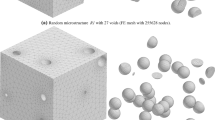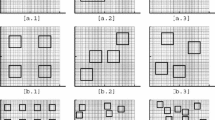Abstract
This paper investigates the possibility that ductile fracture occurs by the McClintock-Berg mechanism of localization of deformation within a narrow shear band, owing to the progressive softening of the material by increasing porosity due to void growth. The ductility predicted for a macroscopically homogeneous sample of a voided material is shown to be unrealistically large and hence an initial inhomogeneity of properties is considered, in the sense of an analysis by Marciniak and Kuczynski in the related problem of local necking in sheet metals. General conditions for a localization bifurcation with an initial inhomogeneity (imperfection), concentrating deformation to allow localization within it, are derived. The initial imperfection is taken in the form of a void-containing, thin slice of a material and is assumed to have a void volume fraction slightly larger than the outside of the imperfection. Elastic-plastic constitutive rate relations for void-containing materials proposed by Gurson are adopted to the conditions for the localization bifurcation. The critical conditions are analyzed numerically to discuss the sensitivity of localization conditions to an initial imperfection, in consideration of the implications for the theory of ductile fracture. The results suggest that the existence of an initial imperfection makes it possible for localization to occur at a reasonable strain, and the predictions from this analysis seem broadly consistent with reported experimental observations.
Résumé
Le mémoire étudie la possibilité que les ruptures ductiles se produisent par un mécanisme de Mc Clintock-Berg afférant à la localisation d'une déformation dans une bande de cisaillement étroite et ce en raison d'un adoucissement progressif du matériau par un accroissement de la densité de porosité associée à la croissance de lacunes. On montre que la ductilité prévue pour une éprouvette macroscopiquement homogène d'un matériau comportant des lacunes est irréellement grande et que dès lors, il y a lieu de considérer une inhomogénéité des propriétés dans le sens d'une analyse par Marciniak et Kuczynski effectuée dans le problème connexe du rétrécissement local des tôles minces. Les conditions générales pour une bifurcation de cette localisation en fonction d'une inhomogénéité initiale (imperfection) ainsi que pour une déformation concentrée qui permette une telle localisation dans cette inhomogénéité, sont déduites de cette analyse. L'imperfection initale est considérée sous la forme d'une mince couche de matériau comportant des lacunes, et est supposée présenter une fraction d'un volume lacunaire légèrement plus grande qu'en déhors de l'imperfection. Pour les conditions de la bifurcation de la localisation, on adopte les relations constitutives élastoplastiques proposées par Gurson dans le cas de matériaux comportant des lacunes. Les conditions critiques sont analysées par voie numérique afin de discuter la sensibilité aux conditions de localisation pour une imperfection initiale, considérant les implications que cela peut avoir pour la théorie de la rupture ductile. Les résultats suggèrent que l'existence d'une imperfection initiale rend possible une localisation sous une déformation raisonnable et les prédictions pour cette analyse paraissent largement consistantes avec les observations expérimentales publiées.
Similar content being viewed by others
References
H.C. Rogers, Transactions of the Metallurgical Society of AIME, 218 (1960) 498–506.
C.D. Beachem, Transactions of American Society for Metals, 56 (1963) 318–326.
J.I. Bluhm and R.J. Morrissey, Fracture in a Tensile Specimen, in Proc. of the First Int. Conference on Fracture, Sendai, Japan, 1965 (T. Yokobori et al., eds.), Vol. 3, Japanese Society for Strength and Fracture of Materials, Tokyo (1966) 1739.
K.E. Puttick, Philosophical Magazine, 4 (1959) 964–969.
J. Gurland and J. Plateau, Transactions of American Society for Metals, 56 (1963) 442–454.
A.R. Rosenfield, Metals and Materials and Metallurgical Reviews, (1968) 29–40.
J.R. Rice, The Localization of Plastic Deformation, in Proc. of the 14th Int. Congress on Theoretical and Applied Mechanics, Delft, North-Holland (W.T. Koiter, ed.), Vol. 1, North-Holland Publishing Co. (1976) 207.
F.A. McClintock, Journal of Applied Mechanics, 35 (1968) 363–371.
C.A. Berg, Plastic Dilation and Void Interaction in Inelastic Behavior of Solids, (M.F. Kanninen et al., eds.) McGraw-hill, New York (1970) 171.
A.L. Gurson, Plastic Flow and Fracture Behavior of Ductile Materials Incorporating Void Nucleation, Growth and Interaction, Ph.D. Thesis, Brown University (1975).
A.L. Gurson, Journal of Engineering Materials and Technology, Transactions of the ASME, 99 (1977) 2–15.
J.W. Rudnicki and J.R. Rice, Journal of Mechanics and Physics of Solids, 23 (1975) 371–394.
Z. Marciniak and K. Kuczynski, International Journal of Mechanical Sciences, 9 (1967) 609–620.
J.F.W. Bishop and R. Hill, Philosophical Magazine, 42 (1951) 414–427.
B.I. Edelson and W.M. Baldwin, Transactions of American Society for Metals, 55 (1962) 230–250.
A.R. Rosenfield and G.T. Hahn, Transactions of American Society for Metals, 59 (1966) 962–980.
D.P. Clausing, International Journal of Fracture Mechanics, 6 (1970) 71–85.
D. Broek, Engineering Fracture Mechanics, 5 (1973) 55–66.
L.E. Malvern, Introduction to the Mechanics of a Continuous Medium, Prentice-Hall, Inc., New Jersey (1969) 169.
Author information
Authors and Affiliations
Rights and permissions
About this article
Cite this article
Yamamoto, H. Conditions for shear localization in the ductile fracture of void-containing materials. Int J Fract 14, 347–365 (1978). https://doi.org/10.1007/BF00015989
Received:
Revised:
Issue Date:
DOI: https://doi.org/10.1007/BF00015989




